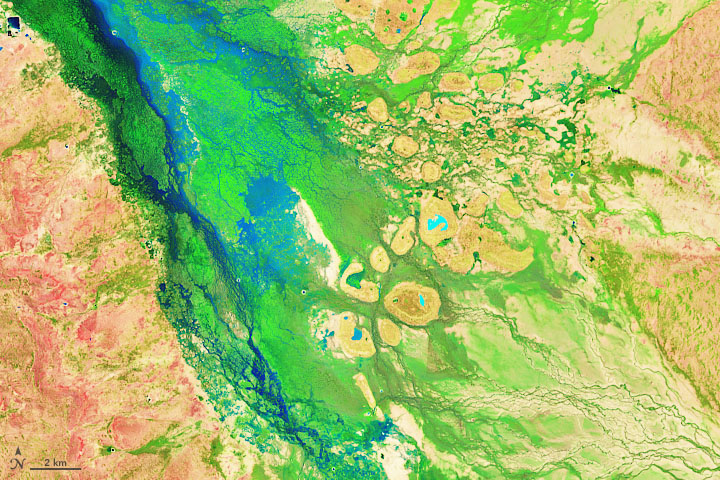

In early March 2020, seasonal rains and Tropical Cyclone Esther combined to drop historic amounts of rain over western Queensland. Some areas saw their largest downpours in nearly two decades, bringing much-needed relief to drought-stricken regions.
The rain filled waterways in Channel Country, a region in Queensland and South Australia known for its braided streams and alluvial plains. Many of the waterways empty into nearby terminal basins such as Lake Eyre.
The images on this page show swollen rivers and wetlands near the town of Thargomindah, which recently experienced its wettest day in 21 years. The first image shows Lake Bindegolly National Park, located about 40 kilometers (25 miles) east of Thargomindah. The second image shows a stream just south of Lake Bindegolly. Both images were acquired on March 8, 2020, by the Operational Land Imager (OLI) on the Landsat 8 satellite.

Around the time the images were acquired, weather stations near the Thargomindah airport recorded 20 centimeters (8 inches) of rain in two days—more rainfall than the area experienced in the past two years total, according to news media. The nearby Bulloo River also crested at approximately 5.4 meters (18 feet). The rain flooded several towns in the region, stranding residents and halting some businesses, but also nourishing parched grasses.
In upcoming weeks, the flooded watercourses in Channel Country are expected to empty into the Lake Eyre Basin, one of the driest areas in Australia. The ephemeral, seasonal lake supports a diverse ecosystem of birds, insects, and fish. According to the latest available data in February 2020, about 19 percent of the land of Lake Eyre Basin received above average rainfall amounts.
NASA Earth Observatory images by Joshua Stevens, using Landsat data from the U.S. Geological Survey. Story by Kasha Patel.